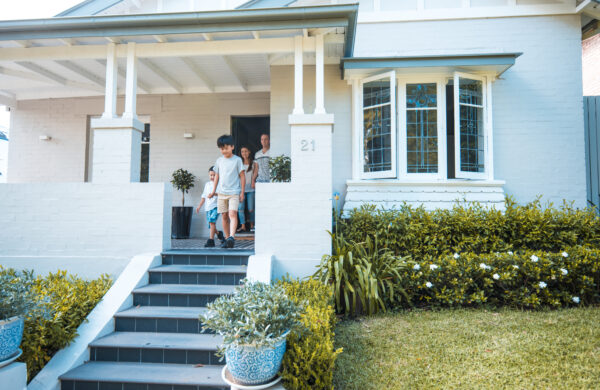Anyone who owns a home should carry homeowners’ insurance. If your home is considered high-value, you may need to purchase coverage through an insurance company that specializes in protecting high-value properties. Although the exact cutoff value can vary, insurance companies often consider homes with replacement costs of at least $750,000 to be high value.
How is high-value home insurance different from standard home insurance?
High-value home insurance is similar to standard home insurance for lower-value homes in many ways, particularly in terms of the types of losses it covers.
According to the Insurance Information Institute (III), homeowners insurance policies typically provide four essential protections:
- Coverage for the structure of your home. This usually covers losses like fire, hail, lightning and storms but not losses caused by floods, earthquakes and routine wear and tear. If a covered loss occurs, the policy will pay for the cost to repair or rebuild the property, up to the policy limit. This may cover sheds and other detached structures.
- Coverage for your personal belongings. Your home insurance policy also covers your clothes, furniture and other personal items. Protections may extend to items damaged or stolen outside of your home. However, the III says personal belonging coverage is typically capped at around 50 percent to 70 percent of the home structure limit, with lower limits for individual items and losses that occur outside the home.
- Liability coverage. A standard homeowners insurance policy covers certain third-party lawsuits, including lawsuits involving guests who are injured on your property and damage your pets cause to other people’s property.
- Additional living expenses. If your home suffers damage, you may need to stay in a hotel until the repairs are complete. The additional living expenses portion of your homeowners insurance policy covers hotel costs as well as certain other expenses that go beyond your usual living expenses if you can’t live in your home due to a covered loss.
A high-value homeowners insurance policy will provide these four coverages with higher coverage limits than you gain from standard home insurance. Additionally, a high-value homeowners insurance policy may have additional services or add-on options that people who own high-value homes tend to need.
If your luxury home is a vacation property, you will need a policy that covers property that remains uninhabited for prolonged periods. Since vacation homes can incur additional risks – such as trespassers and squatters – you’ll need to talk to your insurance agent to make sure you have the right coverage in place.
Talk to a Homeowners’ Insurance Specialist
Actual Cash Value vs. Guaranteed Replacement Cost Coverage or Extended Replacement Cost Coverage
Imagine a wildfire tears through your community, destroying your luxury home and everything inside. Thankfully, no one is injured and your homeowners insurance policy covers wildfires. You file a claim with your insurance company, assuming your loss will be fully covered. However, the claims professional handling your case says your limits aren’t high enough to cover your entire loss. Construction costs have surged and your limits haven’t kept up. You’ll have to cover the difference out-of-pocket.
To avoid a scenario like this, when you buy a high-value home insurance policy, you need to make sure your coverage limits are high enough to cover your house as well as your belongings. Although this seems simple, there are actually different ways of determining value – and the method used can make a big difference.
- Actual Cash value only covers the value minus depreciation. Since many items lose value over time, a policy operating on a cash-value basis may not provide enough coverage to replace your belongings.
- Replacement cost value means depreciation will not be subtracted from the value. A policy that operates on a replacement-cost basis will cover the costs required to replace your property, up to the policy limit.
- Extended replacement cost value will add an additional buffer of around 20 percent. This buffer protects you from cost increases that may occur due to inflation and other market conditions.
- Guaranteed replacement cost value means that your house is covered for the full replacement cost. Guaranteed replacement cost coverage provides the greatest level of protection for your high-value home.
How Home Insurance Covers High-Value Items
Homeowners insurance includes coverage for personal belongings, but this coverage may not be adequate for high-value items, such as jewelry. For example, if your policy includes a limit of $2,000 per item but you have individual pieces of jewelry worth $10,000 or more, you will not have sufficient coverage these items.
You can buy a separate policy for these items or secure additional coverage by scheduling your high-value items individually on your homeowners insurance policy. To see if you need to schedule your items or purchase additional coverage, check your policy for the limit on individual items – this will be much lower than your total limit for personal belongings. Then, conduct an inventory of your high-value items. For any items that are worth significantly more than the limit, contact your insurance company to see what you need to do.
Be sure to notify your insurance partner of any collections you may own – from wine and fine art to coins and stamps. Be sure to also discuss recreational equipment such as ATVs, boats, jet skis, equestrian equipment or firearms.
Liability Insurance and Umbrella Coverage
Your homeowners insurance also includes some liability protection and owners of high value homes often have a greater exposure to lawsuits.
For example, you may entertain guests or host more events than a typical homeowner, which creates a greater chance of someone being injured or overserved on your property. You may also hire more people to work at your home, creating additional injury exposures.
If you have a pool, people may trespass onto your property to use the pool without your permission. If a child does this and is injured, the family could sue you on the grounds your swimming pool posed an attractive nuisance. A similar situation could arise if you own horses or other animals that people may try to pet without following proper safety precautions.
Some people may also fraudulently sue you because they assume they’ll receive a lucrative payout. For example, someone might stage a slip-and-fall accident on your property to sue you.
You can protect yourself with strong liability coverage. Check the limits on your homeowners insurance policy. If these don’t seem high enough, talk to your insurance agent about raising your limits.
It’s also a good idea to carry umbrella insurance. This provides excess liability coverage on top of your homeowners insurance, auto insurance and boat insurance policies. If you exhaust the limits of your base, your umbrella coverage will kick in. This can be an affordable way for high-net worth households to obtain more coverage for multiple liability types at once. However, your insurance provider will still require you to maintain base policies with adequate limits.
Is your luxury home adequately protected?
Whether it’s your main residence or a vacation home, your high-value home deserves luxury home insurance. An insurance agent at Higginbotham can help you secure insurance for your high-value home with the terms and limits you need as well as other coverage types that make sense for your situation. Learn more.






